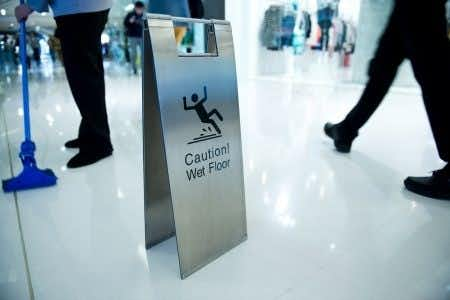This case involves a female customer at a shopping mall who suffered a traumatic brain injury after a fall in the mall’s restroom. Approximately two hours before the incident, mall staff was notified by a customer that the women’s restroom floor was covered in water. The customer was assured that the bathroom would be cleaned, however no action other than the placement of a single wet floor sign was taken. The plaintiff then entered the bathroom and slipped on the wet floor, striking her head on the counter top and suffering a serious concussion. It was claimed that the shopping mall failed to take sufficient action to remediate the wet floor and prevent customer injuries.
Question(s) For Expert Witness
1. Please discuss your background in establishing safety protocols for bathrooms.
2. What are the follow-up measures when informed that a bathroom is wet and slippery? Did the sign in this case provide adequate warning to patrons?
Expert Witness Response E-011912
Typically, a wet floor sign is sufficient notice to a pedestrian that the slip resistance/friction on the walking surface is reduced and that their stride mechanics must to adjusted to accommodate this. The phrase "Slippery when wet" is axiomatic in the U.S. Bathroom floors are frequently wet due to several considerations such as the need for frequent mopping/cleaning, users missing the toilet facilities, and spills on floors after hands are washed. This results in it being important that bathroom floors are slip resistant even when wet. Depending on the nature of the flooring in the facility, this may or not be true, but can be ascertained through testing using any of several commercial tribometers ("slipmeters"). Another consideration is that floors are frequently mopped with a soap solution of some type, but are less frequently rinsed afterwards to remove the soap residue. If the floors are not rinsed and the soap residue remains on the floor, it can re-emulsify (go back into solution) when water is dropped on the floor. This can result in the floor not only being wet, but wet and soapy decreasing the slip resistance even farther than would be the case with only water.
About the author
Joseph O'Neill
Joe has extensive experience in online journalism and technical writing across a range of legal topics, including personal injury, meidcal malpractice, mass torts, consumer litigation, commercial litigation, and more. Joe spent close to six years working at Expert Institute, finishing up his role here as Director of Marketing. He has considerable knowledge across an array of legal topics pertaining to expert witnesses. Currently, Joe servces as Owner and Demand Generation Consultant at LightSail Consulting.



